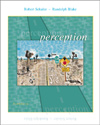|
 |  Perception, 4/e Robert Sekuler,
Brandeis University
Randolph Blake,
Vanderbilt University
The Human Eye
Chapter OverviewThis chapter has laid out the basic design of the human eyeball, emphasizing the good fit between its structure and the job it must do. Because vision depends on an interaction between light and the eye, we also considered how light itself manages to capture information about the environment, information that is conveyed by light. This led us to a discussion of the eyeball's optical characteristics and various common imperfections in those characteristics. The chapter ended with the capture of light by photopigment molecules and the first step toward seeing - photoreceptor responses that are communicated to other neurons in the retina and eventually to the brain. The next chapter follows these messages as they pass from one retinal neuron to the next. The knowledge that vision mirrors the properties of the photoreceptors will lead in the next chapter to a discussion of how other elements in the retina also control what is seen. |
|
|



 2002 McGraw-Hill Higher Education
2002 McGraw-Hill Higher Education

 2002 McGraw-Hill Higher Education
2002 McGraw-Hill Higher Education